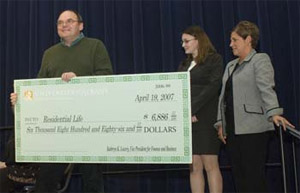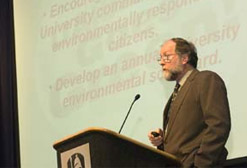Campus Update
By Greta Petry (April 23, 2007)
Robinson: "All in the Same Boat" on a Greener UAlbany

A check for savings from decreased use of electricity in the residence halls was presented at the Spring Faculty Meeting April 19.
The University at Albany is buying more local produce, is reducing its use of electricity, and in general, is becoming greener, according to Associate Professor of Biological Sciences George Robinson, a co-leader of the Task Force on Environmental Sustainability.
Robinson, at the Spring Faculty Meeting held April 19 in the Campus Center Ballroom, updated faculty and staff on the progress made over the past year.
Using humor and visuals to make his points, Robinson began by saying "some of us are extra responsible" when it comes to being better stewards of our natural resources and "some of us are clueless."
Nevertheless, over the past year, the University has made strides towards buying local produce, recycling more of its garbage, and reducing its use of electricity. Showing a slide of a trip taken earlier this academic year on the Sloop Clearwater (a traveling hub of environmental education), Robinson quipped, "We're all in the same boat."

Associate Professor of Biology George Robinson told the audience UAlbany is buying more local produce, recycling more of its garbage, and reducing its use of electricity.
Turning to the issue of land use, Robinson noted that 61.5 percent of the Downtown Campus, 48 percent of the Uptown Campus, and 24 percent of the East Campus are "hard surfaces," that is, neither lawn nor forest. Making the campus a more "human-centered environment" rather than one that is geared towards cars and concrete remains a focus. Reducing deforestation remains a challenge.
Recent progress has been made on other fronts. Previously, the University was paying $8 to recycle each computer monitor that was discarded; now, we are making eight cents a pound on all electronic equipment we recycle, Robinson said.
Turning to the Recyclemania competition, Robinson noted UAlbany was in the middle of the pack nationwide in upping its recycling tonnage. Sounding a positive note, he said we are still getting started in this area and we are doing something right in terms of education.
Still, more needs to be done. Showing a photo of a recycling bin for dry cell batteries that was taken in the Campus Center, Robinson pointed out that trash had been thrown into the bin as well. Next, showing a slide from UMass, Amherst, where each recycling outpost has three bins, with one designated for regular trash, he noted this is what the UAlbany campus needs. Otherwise the recycled materials are contaminated by the regular trash.
Goals have been set for "green commerce" on the Albany campus. Robinson said we seek to have more working drinking fountains to reduce the number of disposable drink containers. We also seek to increase the percentage of recycled paper products bought from 50 percent to 75 percent by 2010. In addition, the goal is to buy five percent of produce locally by Fall 2007, increase the number of Farmers' Markets held on campus, and develop a local food caf�.
Finally, searches are under way for a full-time task force director, as well as an energy director in order to sustain the work of the volunteer task force.
